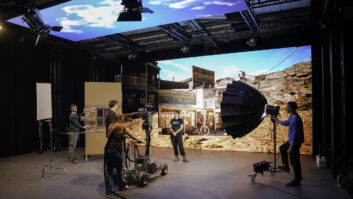Over the past year, the Covid-19 pandemic has completely transformed the way businesses operate — driving companies to embrace digital innovation through the use of technology.
This is also true for the VFX sector. Since the beginning of the pandemic, film and television companies have started to embrace more innovative techniques like virtual production in order to improve efficiencies across the overall production process.
While virtual production isn’t anything new, the pandemic has certainly put a spotlight on the benefits of the technique which was fast becoming a large part of the production process even before the pandemic. While the main benefits of virtual production are the way it enables pre-production creative collaboration and an iterative approach to filmmaking, an additional and surprising benefit of virtual production is its ability to help companies become more sustainable.
While it may not be the primary issue promoting the rise of virtual production, sustainability is indeed a pressing issue in the production world. Blockbuster films with budgets of over $70 million produce an average of 2,840 tonnes of CO2 per production, a figure equivalent to the amount absorbed by 3,700 acres of forest in one year.
Around 51 per cent of emissions were related to transport, with 30% of that accounted for by air travel and 70% by land. The rest was due to energy consumption, with 34% of the average blockbuster’s CO2 emissions going on mains electricity and gas, and 15% on diesel generators.
It is also reported that resource consumption and associated carbon emissions are frequently underreported by productions, and in some cases not reported at all. The industry needs to take significant steps to change this and adopting virtual production techniques could be the start of that.
On set sustainability
Simply put, virtual production is where the physical and digital worlds meet through a combination of immersive technologies like virtual reality (VR) and augmented reality (AR). This offers many benefits for directors’ creative processes by allowing them to see what the fully rendered scene will look like while they are shooting.
Virtual production also offers several logistical benefits as it allows for more iterations of scenes or shots to be created with fewer people and in a shorter space of time. Another example of the logistical benefits of using virtual production is there potentially isn’t the need for as many extras as background characters can be more easily created within the game engine. This also applies to physical props – which can be substituted with computer-generated objects – helping to reduce material waste even further.
The need for a reduced number of crew on set also means less resources will be used – with less food waste, less packaging and even less people consuming energy.
These logistical benefits aren’t a purely practical concern. They also overlap with the creative benefits of virtual production. Because directors can be much more confident that they will know that they have captured the right shots on set, it means they can put an increased focus into the planning process. This has the benefit of further streamlining and minimising the ‘on set’ time that is actually required.
Reduced travel
However, the major benefit relates to travel. By being able to build fully rendered digital environments on a single set, there is less of a need for productions to travel to several shoot locations.
Often Blockbuster productions are filmed in numerous countries around the world. But as touched upon earlier, around 51 per cent of CO2 emissions were related to transport, with 30% of that accounted for by air travel and 70% by land, so cutting back travel is key to tackling this problem.
Virtual production reduces this by removing the need to travel to several locations to shoot. Whether using green screens or LED walls, it does this by virtually rendering different locations on a single set.
Virtual production is here to stay
During the pandemic the focus on virtual production has been on how it can revitalise an industry that has essentially been at a standstill for over 12 months by offering alternative production methods that require less opportunities for the virus to spread.
As lockdown measures begin to ease and filmmakers look to adapt the production process to continue operating in the ‘new normal’, we will continue to see an increase in production companies adopting virtual production.
Either way you look at it, virtual production is a win-win for the film industry. While it gives directors more visibility of what their film will look like during the production phase, it also has the potential to massively decrease the carbon footprint of a production. With so many advantages for the whole film-making process, it seems certain that virtual production will become an essential tool for every production in the future.







